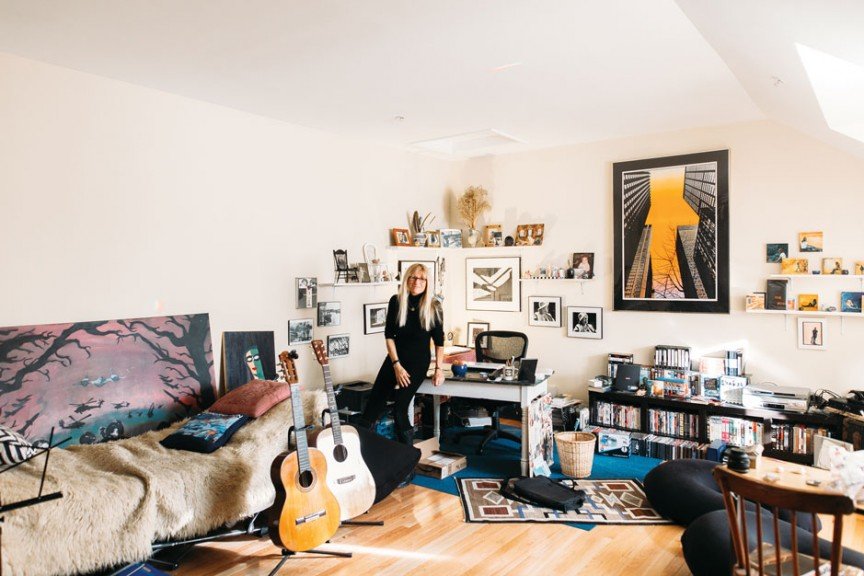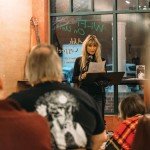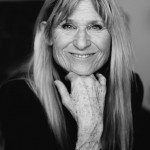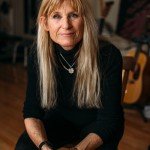+ By Samantha Warburton + Photos by Allison Zaucha
Samantha: We were talking about how, when you became a mother, you became aware of this life inside of you. How does that work with stories and characters? Talk about how a work of art comes to life inside of you, how you become aware of it, and how you nurture it and bring it out of you.
Minnie: Poems usually start with an image, although it can start with a single word, a phrase, even a title. Novels tend to start with ideas or themes I am wrestling with, questions I can’t answer. The piece that I read at 49 West [Café, Winebar & Gallery, in Annapolis] last spring, What Happened on the Denton Road, is eleven poems, “chapters” in a story about a serial killer who is murdering very young girls, eleven to seventeen years old. It began with an image . . . a man driving a truck on a country road toward a stand of trees, twilight turning into evening. I began to follow the image, by which I mean I began to write words down. As I write, one image leads to another image; the sound of a word triggers the sound of another word. I follow the images, I follow the sounds, I follow the visuals almost like on a movie screen.
 What I was seeing was pretty awful, and I thought, “I don’t want to write this . . . ” The first poem was from the killer’s point of view. Then I thought, “what about the townspeople, how did they see him?” And I thought of the stories we hear of serial killers, the people who knew them . . . “You know he was just a good guy, I mean we would never have . . . ” I thought, “What if I tell the townspeople’s point of view?” Then I thought, “You have to have at least one parent in there, a mother who doesn’t even know her child was murdered. There’s no evidence, no body. All she knows is one day her child was there and the next her child was gone. She has no idea what has happened to her daughter.” Then I thought, “I want a girl’s point of view . . . not at the moment this horrible thing is happening to her, but the moments before . . . what makes her decide to get into this man’s truck.” So this whole thing evolved with each voice revealing something new.
What I was seeing was pretty awful, and I thought, “I don’t want to write this . . . ” The first poem was from the killer’s point of view. Then I thought, “what about the townspeople, how did they see him?” And I thought of the stories we hear of serial killers, the people who knew them . . . “You know he was just a good guy, I mean we would never have . . . ” I thought, “What if I tell the townspeople’s point of view?” Then I thought, “You have to have at least one parent in there, a mother who doesn’t even know her child was murdered. There’s no evidence, no body. All she knows is one day her child was there and the next her child was gone. She has no idea what has happened to her daughter.” Then I thought, “I want a girl’s point of view . . . not at the moment this horrible thing is happening to her, but the moments before . . . what makes her decide to get into this man’s truck.” So this whole thing evolved with each voice revealing something new.
In seventh grade, I had an English teacher who had us read Charles Dickens’ Oliver Twist. We were assigned to write a twenty-page short story with no less than ten characters, three main characters, and all the rest minor characters. You had to have all these different plotlines going, and you had to wind them all up, Dickens style. That was the first time I learned to write from many voices and to pull a whole storyline together with a lot of characters.
Year later, in the ’80’, I wrote for daytime television—The Guiding Light and several other soaps. In that kind of story writing, the questions are, “What if, whose voice, whose point of view?” In What Happened on the Denton Road, we get the killer, we get the parents, we get the girls, we get the deputy sheriff on the case, Big Angus, and we get the retired sheriff, Old Tom.
Samantha: It sounds like what came into your mind, unbidden, was an image, one character, and from there your work of nurturing it was to create a whole story, to bring out all the different pieces that would turn that into something that is complete and whole and robust in a way. Is that . . . does that sound right?
Minnie: Yes. In What Happened on the Denton Road, the challenge was not just getting inside that character, but writing in such a way that their voices reach from their gut to yours. When I read that piece to an audience, people cried. I believe it touched their personal grief. That’s what happens if you get to the emotional truth of a character or story. An emotional truth will be universal. It will be shared by other people.
 When I wrote the novel Mykonos (Coward, McCann, & Geoghegan, 1979) I wanted to write a book that tackled being fifteen years old the way I had experienced it, the way I had lived it. I wanted a fifteen-year-old girl reading it to say, “Somebody knows what it feels like . . . ” The craziness of being a teenage girl, the angst, the confusions, the raging sexual hormones, the loneliness, the isolation; for my character Delphine, the constant battles with her sister and her mother . . . I started with that.
When I wrote the novel Mykonos (Coward, McCann, & Geoghegan, 1979) I wanted to write a book that tackled being fifteen years old the way I had experienced it, the way I had lived it. I wanted a fifteen-year-old girl reading it to say, “Somebody knows what it feels like . . . ” The craziness of being a teenage girl, the angst, the confusions, the raging sexual hormones, the loneliness, the isolation; for my character Delphine, the constant battles with her sister and her mother . . . I started with that.
Midway through, another force came into play. This girl believed, as every fifteen-year-old girl must, that she was autonomous and independent, making her own choices. So when she looks at a boy and decides to have sex for the first time, she honestly believes she’s made this decision all by herself. She has no idea that everything from her conception on . . . her birth, her early childhood, have preordained that decision. At least that’s how I saw it at that time and how I still see it to a certain extent. That engendered a section of the book that one reviewer referred to as “the longest flashback in literary history!”
Samantha and Minnie both laugh.
Minnie: I wasn’t writing a young adult novel. I was writing an adult novel for fifteen-year-olds. I also wrote out of my personal understanding of what shapes us, our actions and our decisions. When I write, my stories, be they poems or novels, are going to be based on not just my emotional truth but certain truths I have come to accept for myself. They may not be your truths, and you may disagree.
Samantha: You’re also incredibly aesthetic. When you’re working on poetry, your editing is not just word choice, it’s also placement on the page. It’s spacing. How do the aesthetics intersect with that sense of moral and ethical obligation?
Minnie: I work in stages from rough draft to final edit, be it poem or novel. Form is the aesthetic but it’s also the guide in a novel, a story or a poem. Form has to serve the story. The form has to keep the reader moving. You don’t want the reader to get bogged down somewhere.
 Poems, I have to read aloud. Yours, mine, anyone’s. I have to hear them. So the final stage of my poetry editing is to make sure that my eye is being given the beats and pauses, which tell me the sound of the piece. The oral performance dictates the form on paper. Sound is the essence of poetry.
Poems, I have to read aloud. Yours, mine, anyone’s. I have to hear them. So the final stage of my poetry editing is to make sure that my eye is being given the beats and pauses, which tell me the sound of the piece. The oral performance dictates the form on paper. Sound is the essence of poetry.
The same is true in a novel. The punctuation, the spacing of a page—it’s all for the ear. What do you hear as you read. In my world, you better hear dialogue! Think of the opening line of Little Women:
Samantha and Minnie together: “‘Christmas won’t be Christmas without any presents,’ grumbled Jo . . . ”
Minnie: You’re IN IT! You are instantly in any story that begins with a line of dialogue. You’re there. So how do I hold you? Someone else has to say something. Keep the dialogue going, or if you’re not going to, then give me a piece of action. Children’s novelists—great children’s novelists—knew how to get kids reading.
Samantha: What strikes me is that the emotional truths that you tell, they’re not typically the easy ones, the pretty ones, right? The emotional truths that you tell often are ones that can be hard to sit with, so the aesthetics, the story, the rhythmic-ness of it, those are the things that draw you in. By using those elements to create beauty and an immersive experience, it’s almost like it makes space for you to sit with those truths.
Minnie: I write some very violent scenes. I write about the effects of violence on family members. Mario Puzo (The Godfather) was a master at writing violence. But there’s a difference between describing violence and describing the horror of being a victim of violence. The discovery of a violent act can be terrifying and traumatic. In the novel I am working on now, a little boy is going to discover what has been done to his mother. As the reader, you are with him every step of the way as he gets up the courage to get out of bed, to walk down the long hall to the kitchen . . . That kind of scene I learned how to write from Stephen King. No one has mastered the art of keeping that suspense, the fear of “what’s going to happen?” the way he has, and he does it by going way inside the character. We see and experience everything from that singular point of view, and we’re with the character, waiting for that thing to happen.
Samantha: We’ve been talking about the core of emotional truth and that thread of moral obligation that goes through your written work. I’m curious … is there a parallel for that in your visual art?
Minnie: Around the same time I started writing the poems for What Happened on the Denton Road, I realized I wanted to do a series of very small paintings, five-by-five inches, six-by-six inches. All of girls—12, 13, 14, 15 [years old]—in that moment where they’re on the edge of their lives. If they’re sitting, they’re thinking about where they want to go. If they’re walking, they’re walking the road that they’ve always walked but they’re thinking about the road they’re going to walk one day. They’re not there yet. They’re not gone. But they’re getting ready to go. They’re in that formative period. And I knew that I didn’t want the viewer to see the girls’ faces. They are turned away. They are moving away from us.
 When I did the first one, I had already done two of the poems for What Happened on the Denton Road, and I had this awful feeling. I looked at the girl in the painting and thought, “Oh my god, what if she’s one of the girls?” And that was horrendous to me, the idea that I might have painted a girl that even fictionally was killed by this man. And I thought, “Is there some way I can save this girl’s life?” Like, if I made a painting for sale and somebody bought it—okay, magical thinking—it would save her life. But then I thought, if I sold the paintings and I donated the money to the National Center for Missing and Exploited Children (NCMEC) or to CASA, Court Appointed Special Advocates for Children, which takes care of our children in the foster care system, then that donation to NCMEC or CASA might in fact save a child’s life. And that’s when those paintings began to pour out of me. I just started doing one after another.
When I did the first one, I had already done two of the poems for What Happened on the Denton Road, and I had this awful feeling. I looked at the girl in the painting and thought, “Oh my god, what if she’s one of the girls?” And that was horrendous to me, the idea that I might have painted a girl that even fictionally was killed by this man. And I thought, “Is there some way I can save this girl’s life?” Like, if I made a painting for sale and somebody bought it—okay, magical thinking—it would save her life. But then I thought, if I sold the paintings and I donated the money to the National Center for Missing and Exploited Children (NCMEC) or to CASA, Court Appointed Special Advocates for Children, which takes care of our children in the foster care system, then that donation to NCMEC or CASA might in fact save a child’s life. And that’s when those paintings began to pour out of me. I just started doing one after another.
As I painted, this sort of web of superstition evolved. One of the final ones was this girl in her jeans and her cowboy boots, striding across a country road, looking straight in front of her, her hair falling over her face, and way down the road is the back of that truck. She got away. All these girls got away. Those paintings suddenly became very bound in with the whole story, but they were counterpoint, not illustration. The whole idea was that these paintings could contribute to saving lives.
Samantha: In your visual art, is that another way of getting at a universal experience? Because those moments of those girls I’ve experienced, I see places and parts of my life in those paintings.
Minnie: I started writing very young. I started journaling at ten years old. I wrote, every single day. I inadvertently trained myself to be a writer. I wrote continually most of my life. In the ’70s, I spent a summer in an art school in Greece. I always drew and painted, but I never had confidence in my work. In 1986, I started taking art classes in Newport, Rhode Island. My teachers there gave me technique and built my confidence. In the ’90s, in Sewanee, Tennessee, I opened an art gallery, which I supported by selling my own paintings and drawings, enabling me to take a very low commission on sales of work by artists I represented in the gallery. Around that time, I looked at my paintings and thought, “When I write, I write an autobiography of pain. When I paint, I paint an autobiography of beauty.”
 My painting is all the wonders and beauty I’ve gotten to see in my life. In my writing, I go to this place inside me that is painful and scary and oftentimes dark. It comes out of the childhood abuse, it comes out of being raised in an abusive, alcoholic home, and the recovery, which has given me the willingness to say, “If telling that story, sharing my experience helps one other person, then I will tell the story . . .” I have pages where every single time I work on them, I sit there with tears running down my face. That doesn’t happen in my painting.
My painting is all the wonders and beauty I’ve gotten to see in my life. In my writing, I go to this place inside me that is painful and scary and oftentimes dark. It comes out of the childhood abuse, it comes out of being raised in an abusive, alcoholic home, and the recovery, which has given me the willingness to say, “If telling that story, sharing my experience helps one other person, then I will tell the story . . .” I have pages where every single time I work on them, I sit there with tears running down my face. That doesn’t happen in my painting.
One thing I believe in as a writer is resolution. I don’t want to leave you in the darkness. I won’t leave you in that place. I will not do that to you. I do not believe in it. I need to give you catharsis. My high school English teachers taught us Greek tragedy and what catharsis meant. And I came to understand how important that is for a reader. You have to have that soul cleansing.
Samantha: You are a fierce and relentless editor. There’s a tremendous amount of pruning, a stripping away of what doesn’t need to be there. The thing that I am curious about is whether you see editing as creativity in itself or as diligence. Is that just the hard work you have to put in, or both, or neither?
Minnie: As a kid in school, editing was the boring part. The writers I read in my twenties, I didn’t really grasp what they were talking about until I’d done enough of my own editing. Yes, editing is the hard work, it is the diligence, but it’s become the work that I love. Editing is writing. Ultimately as an editor I am ruthless. If what I’ve written isn’t necessary to the story, I have to catch that.
Samantha: Getting to an emotional truth is by nature a private experience, but it’s also a public experience when you’re doing that in writing, especially in performance poetry. Therefore, much of that editing, pruning, and research, that perfecting, must be for an audience as well. So how does the knowledge of the audience shape what you do and give life to what lives inside you?
Minnie: If I sent my poems out for publication, and I don’t, my approach to my poetry might be somewhat different than it is. Because I do my poetry only as performance, only to be heard, the knowledge of a listening audience very much dictates how I write the poem. I’m not into obscurity, I’m not into symbolism. I don’t want to lose you when I’m reading to you. Especially if I’m reading for 35 to 40 minutes. I need to keep you with me.
When I was pregnant with you, my agent got me work writing paperback romances. This was in the early 1980s, when there was a paperback romance boom. They were hitting the stands like comic books. I had to ask myself, “Who is my audience?” She was the night nurse on duty with a terminally ill patient. She was a thirteen-year-old girl reading under the bedcovers with a flashlight after she’d been told to go to sleep. She was the woman in the neighborhood drugstore whiling away her time as her daughter bought makeup.
My audience for the novel I’m writing now, in a way, is all of us. It is certainly the people who lived through the era of the Vietnam War—whether you fought or stayed home or left the country—we were all in it together, even if it didn’t feel that way at the time. And my audience is all of us now. We have lived through almost a decade and a half of war in Iraq and Afghanistan. We are all impacted by it.
Samantha: Okay, is there anything that I haven’t asked about that you want to talk about?
Minnie: Every good story must take on its own life. I have to let the characters be true to themselves even if I don’t like what they are doing. When I realized what that driver in the pick-up truck was doing to those girls, I didn’t want to write it. I told myself, “You have to go with it. You’re being given these images.”
That’s where you get into the strange and mystical part of the whole process. If someone asks me directly what happens when I write: My fingers hover above the keyboard, I listen, and I watch. And then I transcribe. And my job is to transcribe in the best English I can, to serve the story that is being given to me the very best I can.
I see the stand of trees. I see the dark earth. I see the sun going down. I feel the cold creeping up. I see it. And I write what I see. I have no memory of what I write, only what I saw and heard. █































